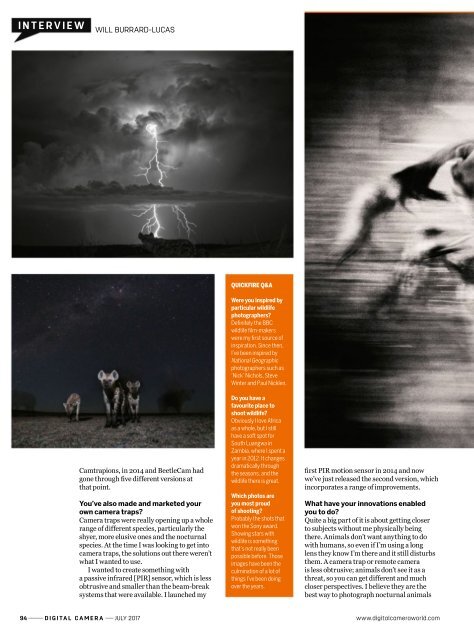Digital_Camera_World_Issue_192_July_2017
Create successful ePaper yourself
Turn your PDF publications into a flip-book with our unique Google optimized e-Paper software.
IntervIew<br />
Will Burrard-lucas<br />
Camtrapions, in 2014 and BeetleCam had<br />
gone through five different versions at<br />
that point.<br />
You’ve also made and marketed your<br />
own camera traps?<br />
<strong>Camera</strong> traps were really opening up a whole<br />
range of different species, particularly the<br />
shyer, more elusive ones and the nocturnal<br />
species. At the time I was looking to get into<br />
camera traps, the solutions out there weren’t<br />
what I wanted to use.<br />
I wanted to create something with<br />
a passive infrared [PIR] sensor, which is less<br />
obtrusive and smaller than the beam-break<br />
systems that were available. I launched my<br />
QuIckfIre Q&A<br />
Were you inspired by<br />
particular wildlife<br />
photographers?<br />
Definitely the BBC<br />
wildlife film-makers<br />
were my first source of<br />
inspiration. Since then,<br />
I’ve been inspired by<br />
National Geographic<br />
photographers such as<br />
‘Nick’ Nichols, Steve<br />
Winter and Paul Nicklen.<br />
Do you have a<br />
favourite place to<br />
shoot wildlife?<br />
Obviously I love Africa<br />
as a whole, but I still<br />
have a soft spot for<br />
South Luangwa in<br />
Zambia, where I spent a<br />
year in 2012. It changes<br />
dramatically through<br />
the seasons, and the<br />
wildlife there is great.<br />
Which photos are<br />
you most proud<br />
of shooting?<br />
Probably the shots that<br />
won the Sony award.<br />
Showing stars with<br />
wildlife is something<br />
that’s not really been<br />
possible before. Those<br />
images have been the<br />
culmination of a lot of<br />
things I’ve been doing<br />
over the years.<br />
first PIR motion sensor in 2014 and now<br />
we’ve just released the second version, which<br />
incorporates a range of improvements.<br />
What have your innovations enabled<br />
you to do?<br />
Quite a big part of it is about getting closer<br />
to subjects without me physically being<br />
there. Animals don’t want anything to do<br />
with humans, so even if I’m using a long<br />
lens they know I’m there and it still disturbs<br />
them. A camera trap or remote camera<br />
is less obtrusive; animals don’t see it as a<br />
threat, so you can get different and much<br />
closer perspectives. I believe they are the<br />
best way to photograph nocturnal animals<br />
94 DIgItaL <strong>Camera</strong> JulY <strong>2017</strong> www.digitalcameraworld.com


















